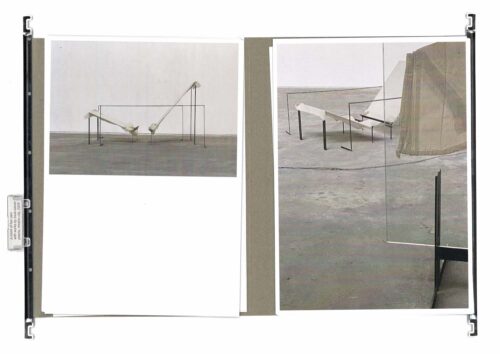TEXT DZENANA MUJADZIC | FIRST PUBLISHED IN CHAPTER №X »STATE OF THE ART« — SUMMER 2023/24
In his works, the Vienna-based artist Lukas Gschwandtner deals with the human body in both physical and psychological relation to its surroundings. The almost poetic expression of his extensive studies and precise reflections manifests itself not only in his handling of the chosen materials, but also in his extended, backdrop-like staging of the (exhibition) space.
Chapter In your ongoing series »Pillow Portraits«, you focus on the human body and its interaction with space, furniture and objects. How did this exploration come about?
Lukas Gschwandtner The series »Pillow Portraits« is based on my long-standing collection of historical paintings of ladies resting on chaise longues, whose non-self-staged body language I wanted to understand. In most cases, their poses were chosen by male artists who wanted to portray them in a certain body language, surrounded by objects that would define the sitter. But the focus is also on the chaise longue itself. So in my series »Pillow Portraits« I try to create a direct and abstracted translation of the depicted body languages. A portable »canvas volume« that directs the body to lie as the portrayed person does. For me, these are mainly personal studies that help me to understand the physical, aesthetic and sociological dimensions of the painter’s decision – but above all I try to understand the physical dimension for the female models, especially as the result of the poses they assume is usually very uncomfortable and unnatural. It is important to me that »Pillow Portraits« can be worn and understood individually, but at the same time serves as a universal tool to grasp the sometimes problematic themes of historical painting.


Chapter In your work, for example, you question furniture as a purely functional object. What social dimension do you personally attach to furniture?
Lukas Gschwandtner What interests me about a piece of furniture is the direct contact with the body in use––a construction that supports and guides the body and at the same time determines its body language. Apart from that, the historical aspect of a piece of furniture is very important to me. The research itself is essential in order to understand the origin of the furniture and to be able to pass it on. In the context of restoration, I find it exciting to be able to reconstruct and deconstruct pieces of furniture.


Chapter Your exhibition »A Room of Her Own« seems to distil the essence of Margarete Schütte-Lihotzky’s »living room/bedroom furnishings for Mrs. C. Neubacher«. What considerations preceded the realization and how did you approach such a multi-layered, socially charged source work?
Lukas Gschwandtner Margarete Schütte-Lihotzky’s life story and her work have been with me for a long time and continue to influence me in new ways. The living room and bedroom she designed for Karoline Neubacher (1925) is part of the permanent collection of the Museum of Applied Arts (MAK) in Vienna. Over many years I have visited this room and measured the details with my eyes (without forbidden scanning) and found the dialog between upholstery, upholstered furniture and wood construction, their wear and tear, exciting, as well as how all components come together as a unit in the spatial image. In Mexico City, together with the Peana Gallery, I was able to translate Margarete Schütte-Lihotzky’s living room and bedroom. The translated canvas corpus (Canvas Fossil) concentrates on the surface of the room objects, acting almost like their skin. The substructure functions as a skeleton of linear steel elements reminiscent of a drawing. The stone drawings clarify the proportions and volumes of the furniture. These constructs serve as spatial drawings that can be read differently depending on the perspective. In order to transfer the floor plan and proportions of the living room and bedroom, the textile fossils were pressed between glass walls and formatted according to the floor plan of the room. For me, the overall picture of the exhibition with all the fossils floating in glass represents a family portrait of Margarete Schütte-Lihotzky’s designs––details archived by me with historical context.



Chapter The staging of your works has a stage-set-like effect. What importance do you attach to the atmospheric and purely visual components in your work?
Lukas Gschwandtner For me, the works stand together with the surrounding space as a whole. Perhaps it can be understood as an unspoken overall picture that I unconsciously try to create. I find it incredibly fun to move from a small scale to the largest areas of the room. This allows me to see and understand every detail. Visually, I like it best when I can document my work with my cell phone, especially because the quality is often so poor that the photo can almost be read as a painting. These cell phone photos often make it easier to recognize volumes and proportions than in fancy pictures. I think it’s important to give space a leading role, even in photos. Not forgetting my obsession with scanning––I would love to scan what I have scanned. A scan has a special two-dimensional, pressed quality that makes me think a lot about archiving––my other obsession.


